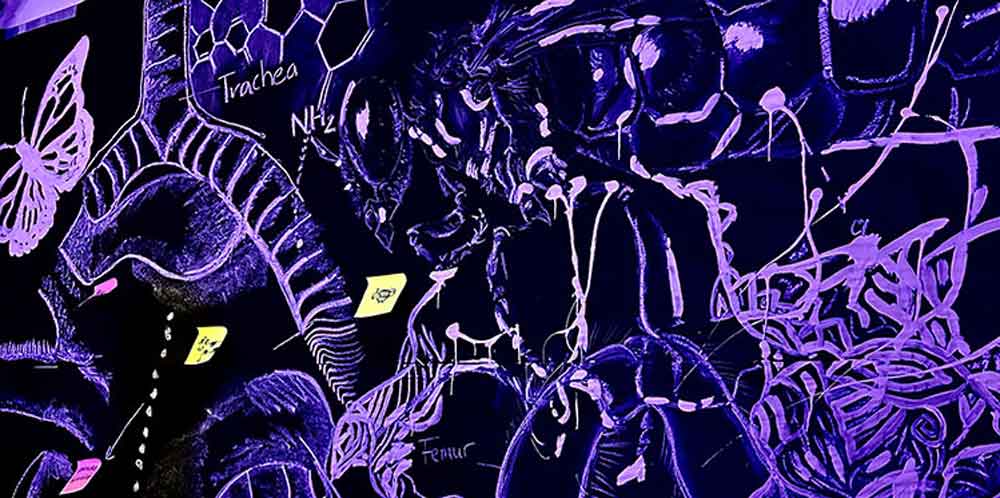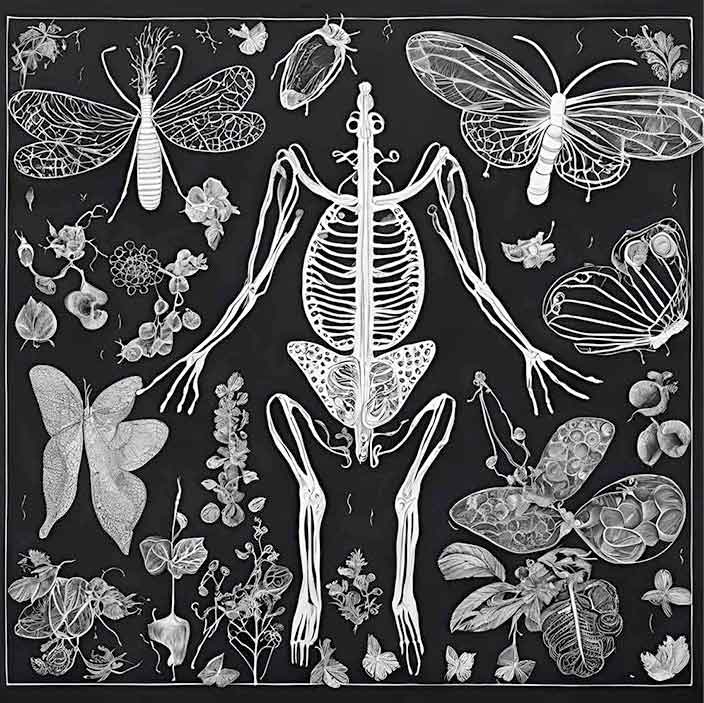
Fig. 1: "TESTVERSION.jpg" - science based drawings, 14m x 1,40m
Under the title TESTVERSION.jpg six art education students performed a large-format drawing at a gallery within the annual art exhibition in the city of Passau in 2024. The drawing process with a huge audience lasted about six hours. We worked with the materials of white chalk and acrylic colour on black paper, illuminated with black light, in the dimensions of 14 m x 1,40 m.

Fig. 2: "TESTVERSION.jpg" - science based drawings (closeup)
This process was supported by Prof. Dr. Lutz-Sterzenbach and Thomas Scharrenbroich. The DiLab (didactic laboratory) of the University of Passau with the experts working in it allowed us to get deeper insight in the field of AI. Within our group we took a closer look at the process of how artificial intelligences work to generate images. A very prominent aspect is the user input in the form of prompts - as the base of instructing the AI. By analogy, we developed a prompt based on our current artistic interests, which served as our task.
The prompt said: "Create a drawing with white colour on a black background. Map scientific drawings on the topic of human anatomy and insects and connect these elements with patterns and DNA strands."
According to that we split up in three groups of two and each group focused on a different thematic aspect within the prompt. A first group engaged with the drawing of human anatomy, the second one with insects, followed by the third group concentrating on creating ornamental elements such as DNA strands and binary codes aiming at drawing connections between the previous groups. The different groups performed in intervals of one hour each.
Each group then did research on their topic in order to prepare for the exhibition. Looking at scientific drawings, we tried to understand their mechanisms and visual language. At the exhibition, we used printed material to recreate the most prominent features of scientific drawings we have chosen before. Usually, the main aspect of collaborative work is communication, which we completely left out. Instead, we spontaneously added on to the work of the previous group to create a dynamic piece. After our artwork was finished, we gave our previously determined prompt to an AI image generator. We tried to reconstruct AI's process of image generation and its differences to our simulation in order to compare the influence of different work processes on the visual imagery.

Fig 3: "TESTVERSION.jpg" - Canva-generated image, usage of the prompt mentioned above
We noticed that the image created by AI (see fig.3) did not completely fulfil the requirements given by our prompt`s instructions. It fully lacked DNA strands and the patterns visible to create connections appeared rather rare and made the image seem two dimensional as it lacked elements of overlap and fusion. AI created the image in a symmetrical layout, a very traditional, stiff kind of pattern. This also seems to be very typical as it is orientated at a principle of composition that can be found throughout art history. In contrast to that, our performative piece showed dynamics, dimensions and unity in the sense of our work creating the impression of "being complete". Our work laid strong emphasis on the process of creating rather than focusing on the result. We believe that huge potential and value lies within the human capability of thinking and going beyond what the visual templates and reference pictures, we chose show us. We have the immanent sense of what is aesthetic, what visually works and what does not, when something is missing and when the composition is strong, complete. It's over the course of the process that decisions were made, upcoming ideas were spontaneously and directly transferred onto the paper, strong connections in the form of overlaps and elements merging into each other were realised on paper.

Fig. 4: "TESTVERSION.jpg" - science based drawings (closeup)
In the case of our performance (see fig. 4), this process became visual, transparent as well as accessible for the public, allowing interaction and dialogue whereas the process of AI image generation takes place in seconds, remaining in the unknown of its inherent systems.

In the process of the artistic work, we collaborated as a group of six, all of us currently studying at the university of Passau, aiming at becoming art teachers. We met during a seminar which dealt with artistic processes in production and reflection, focusing on AI and its relation to art. As we worked towards presenting artworks at an exhibition the six of us came together due to a strong overlap of interests, which lead us performing and drawing together at the annual art exhibition in the city of Passau.
Top row, from left to right: Lea Neuberger, Lydia Schmidt, Anna Unrecht. Bottom row, from left to right: Ann-Sophie Müller, Mia Schiesser; also: Mara Bachl
